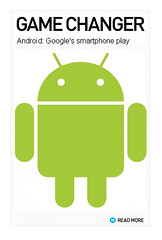I expect this to be the open source Android OS for:
– Smartphones (from $50 to $600) iphone-killer
– Tablets (from $50 to $600) ipad-killer
– Set-top-boxes (from $50 to $200) ARM Powered Google TV 2.0
– Laptops (from $100 to $600) ultrabook/netbook/macbook-killer
– E-readers (from $75 to $300) kindle-killer
and combinations thereof. We can have 1 device that does it all when using MHL/HDMI output and the Pixel Qi LCD.
This is the first Android OS that is ready to use the latest ARM Cortex-A9 processors that not only run at 1.5Ghz (+50% compared to Tegra2) but most importantly also introduce much faster memory bandwidht (+200% compared to Tegra2).
This means devices with Ice Cream Sandwich can now run a full computer. A FULL ANDROID LAPTOP.
Just a sec here. Google has Chrome OS, brace for it…. I think it might merge now.
Think of the Atrix 4G, now over the MHL Connector, you can dock your phone to any HDMI monitor such as your HDTV, get your Bluetooth keyboard and mouse, and your Android phone is now powerful enough to run a full speed 720p or even 1080p Chrome browser.
Laptop makers want to release ARM Powered Laptops without touch screens running Chrome OS only, sure enough, they can do that. But if that Laptop has a touch screen, it can DUAL-BOOT with Ice Cream Sandwich. That is how I see them merge. Basically Android gets a full Chrome browser. And Chrome OS can safely and easily switch to Android mode on ARM Powered devices if needed.
This is the recipe for the ultimate ARM Powered device. Ice Cream Sandwich Powered.
But Ice Cream Sandwich is also less bloatware, a faster user experience, it can run on the cheapest $50 Smartphones to destroy what’s left of Nokia’s Symbian sales in the developing world. It can run on ARM9 like Mediatek, ARM11 like Mediatek and Qualcomm, ARM Cortex-A8 single core processors like Rockchip RK2918 and Telechips 8803, as well as single core ARM Cortex-A9 like AmLogic and low frequency ARM Cortex-A9 like the NEC/Renesas one. But I expect every other ARM Processor to be fully supported. Obviously slower processors may have some UI layers automatically disabled such as having less holographs, less animations, less transitions, so that the OS scales perfectly for every hardware platform and at the same time that it can fully take advantage of the newest fastest performance.
In terms of looks compared to Gingerbread and Honeycomb? I don’t care about the looks, give us whatever the user experience scientists have measured is the absolute best design for a user interface. This is a simplification of the smartphone but at the same time the enabling of new more advanced features for the first time.
Obviously that a Nexus Prime for $529 unlocked with a new 4.65″ 1280×720 Super AMOLED HD screen, with a new TI OMAP4460 or/and a new Qualcomm MSM8660, obviously that is going to be the most awesome reference product for this new version of Android. My question is how much of the Atrix-features for HD web browsing, full Chrome on HDMI output, I wonder how much of that is shown already this October 11th or if the OS is presented for now just as a Smartphone upgrade and that the whole rest of the ecosystem gets added later.
What do you think Ice Cream Sandwich is going to be like?
























